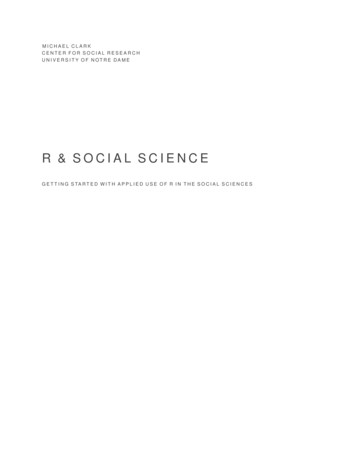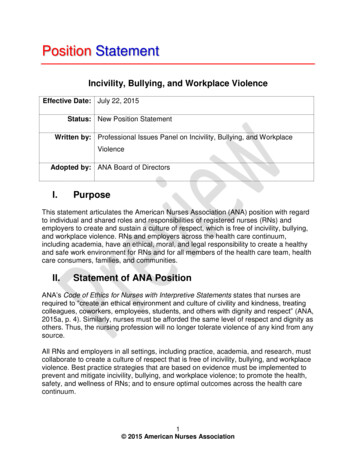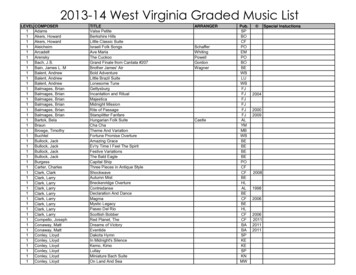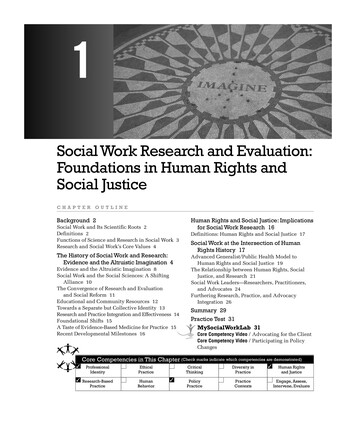
Transcription
MICHAEL CLARKCENTER FOR SOCIAL RESEARCHUNIVERSITY OF NOTRE DAMER & SOCIAL SCIENCEG E T T I N G S TA R T E D W I T H A P P L I E D U S E O F R I N T H E S O C I A L S C I E N C E S
CSRContentsPreface44My Journey to R5R on the Rise5R Popularity Summarized6Overview of R7R is not a stats packageR for Political Science8ExampleEnhancement1111R for Psychology11ExampleEnhancement1213R for SociologyExample13Enhancement15Brief SummaryWorking with DataRData81816172
3R in the Social Sciences18Models23Visualization26Programming in RBasic Benefits2727Code Maneuverability28Project ManagementSupport for Literate Programming & Reproducible ResearchDocument ProductionWeb-based PresentationVersion Control322930Functions & DebuggingSummary283128
CSR4PrefaceCurrent draft August 11, 2014.My Journey to RA little background. While I could go into boring detail, suffice it tosay, and as much as it pains me to do so, I was born an SPSS menuclicker, as far as my stats training goes. I started making the switchover 10 years ago thanks to an acquaintance who had spent moretime in the stats world and was using R. Unlike SPSS, whose baseoffering seemed to center around the content of statistics textbooksof the 1970s, I found that R could easily pull off the modern methodsstatistically minded individuals in social science and psychology wererequesting that applied researchers do. But it could do a lot more, andthe only limiting factor was me. I never learned a thing about statisticsusing SPSS, while I was learning something new all the time withR. When I began using it to teach, and despite the students’ havingthe very same grumblings I had about programming, there wouldactually be light bulbs coming on when they used it. Again, this isn’tsomething I witnessed with SPSS. It was also nice to have a tool theyand anyone could afford. Due to R’s rise in popularity you can nowget a free student, i.e. crippled, version from SPSS, as well as use Rcode within it’s syntax, as well as offering a developer pack so thatyou can use R to make SPSS better (for a price of course). If nothingelse, even SPSS’s own founder jumped ship to R years ago, saying "R isan absolutely massive advancement on the kind of analytics I invented.It’s an opportunity to change the game in the fastest-growing field insoftware."1 .R is both free and freeing. It is not tied down to any particular discipline or industry persuasion. It is easily modified, expanded, and enhanced. In short, R is there to do with what you want statistically, andthe possibilities are endless. You will learn more about your data, yourmodels, and about statistics, by programming in R than you would using canned routines in a typical statistics package. Is it perfect? No, noprogramming language is. But it will do what you want, and what elsereally matters aside from that?While personally I feel the writing was on the wall for applied researchers years ago, the following document will attempt to providespecific reasons for someone else to make a similar switch, particularlythose in the social sciences. By the way, this document was createdwith R in the same environment used for statistical programming2 . Forother examples you can see my documents here.1I’m not sure what analytics he’s referring to as having invented.2Using knitR and other packages, mixedwith LATEX
5R in the Social SciencesR on the RiseR’s popularity has been meteoric over the past 10 or more years. Butyou don’t have to take my word for it. As a starting point we can note aGoogle trends plot over the past 10 years. Note that for the following,since there was no special topic for SPSS programming or statistics,or SAS outside of SAS Institute, so their absolute numbers may beinflated by other things (especially SAS), but the absolute values aren’tas important for our purposes as the trends. The only one notably onthe rise is R.R Popularity SummarizedIn fact there is a regularly updated website devoted to the popularity ofR, maintained by the author of books that help people to migrate fromSAS, SPSS, and Stata3 . I will provide a brief summary4 .Job Advertisements For analytics jobs, R is on the rise while SAS andSPSS are stagnate and other statistical packages aren’t even common. You’d be better off with Python than SPSS skills in the modernanalytics world.Google Scholar Not exactly telling as most articles seem to want youto think that their statistics arise magically from the authors’ skullsand the tools used are left uncited, but SPSS has simply plummetedin Google scholar hits since 2005, while SAS has lost notable groundsince 2008. R, and even Stata, have gained.Published Books R has provided SAS and SPSS a 20 year head start,but has already caught up to SPSS, while SAS is still a ways off.Website Popularity R is second only to SPSS in terms of links to itshomepage, though really that is a comparison to IBM as IBM.com is3I should note that I’ve never comeacross a book with a title that goes in thereverse direction. If you are proficient atR, you have enough programming skillto learn the others, but there is also noneed to.4Several of these are based on resultsfrom two years ago.
CSR6SPSS’s homepage. SAS is a distant second, and Stata notably lowerthan SAS.Blogs It’s not even remotely close here. There are 550 blogs currentlylisted at R-Bloggers.com, while SciPy (Python library) has only atenth devoted to it, which is still more than SAS and Stata combined.Discussion Lists From their own to discussion forums to popular programming sites like CrossValidated, StackOverflow and TalkStats, Rdominates. SAS catches up at places like LinkedIn and Quora. SPSSand Stata are way off the pace.Popularity Measures Several (obviously limited) surveys at sites likeKDNuggets ask big data and analytics folks what tools they’re using,and R is again more widely used than traditional statistics packages,followed by SAS and SPSS. Stata isn’t even on the map here.There are plenty of bones to pick about trying to assess any of theabove outside of a few of the measures, but I think it’s safe to say thatR is very popular right now. Companies like Google, aside from general programmers, aren’t looking for SPSS and SAS proficiency, they’rehiring R programmers. For data driven graphics, the NY times graphicsteam is using R and other programming languages like JavaScript onthe backend, not any other statistical packages5 . So if industry is shifting to R and other programming tools, and the statistical communitylong ago adopted R as their primary tool of choice, it stands to reasonapplied researchers might want to use it as well, and the fact is a greatmany of them already are.In the following I’ll show some specific R tools framed within socialscience applications. Nowadays it’s not uncommon to find someone doing social science research might be a physicist, biologist, or computerscientist, though I have more traditionally trained social scientists inmind. I’ll specifically note a few applications in political science, psychology and sociology. After that I’ll provide specific programmingexamples to show how easy it is relative to other programs. Then I’llsuggests some additional thoughts that go beyond the standard approaches.Overview of RI’m not going to provide a full introduction to R. If you want that youcan see my introduction here. However an overview is in order to giveone the proper context for comparison to alternatives.R has really become the second languagefor people coming out of grad schoolnow, and there’s an amazing amountof code being written for it. You canlook on the SAS message boards andsee there is a proportional downturn intraffic. Max Kuhn, associate director ofnonclinical statistics at Pfizer in a NewYork Times article on R from 2009.5See the blog of their Graphics Editorhere and here for more insight into theirprocess.
7R in the Social SciencesR is not a stats packageR is not a "stats package". R is a true programming language6 - it is adialect of S, which has won awards and has almost as long a historyas SAS and SPSS. Beyond that it is best thought of as a programmingenvironment within which statistics is conducted. In a sense it hasmore in common with Python than it does with the syntax used in statspackages, and that has far-reaching effects for data manipulation andexploration, post-processing of models, and visualization.Base R has most of the functionality you’d find in a traditional statistics package and beyond, plus a system for creating fantastic visualizations. R is open-source, which means that one can inspect and modifyits contents freely. Because of its programmability, it is easy for othersto provide additional functionality in the form of packages, to date ofwhich there are almost 6000. So with R you have a fully functioningstatistical system to start with, and its open nature and programminglanguage allow others to add more features all the time. This is part ofthe reason for its popularity, as well as it always being able to providecutting edge techniques to more applied users.You will have to beef up some programming skills to use R effectively, but serious statistical analysis has always required that, at thevery least for the initial data preparation. Only now it will be easier. Ris what is referred to in programming languages as an object-orientedprogramming, and once you get used to it for your statistical and dataneeds, it will be hard if not impossible to go back to the inefficientmethods of statistical package syntax7 . Yes you can use those to domany of the same commonly employed approaches to data manipulation, and it is easy to get basic model results. However with R it is nomore difficult to work with 1 vs 10 or 100 data sets, you don’t have tocreate explicit representations of variables to use them in modeling orfor simple data exploration, you can avoid loops entirely for commoniterative tasks, prediction is built in to the vast majority of modelingfunctions, you have many plotting methods for results of analysesbuilt-in, you can easily call in or even write and use other languagesfor certain tasks, and you can easily write your own functions (evenimplicitly) and modify others, engage in interactive graphics, write dynamic, publish-ready documents. etc. One key idea to note- you do nothave to be a great R programmer to use it effectively and do some prettyamazing things, but you do have to be an excellent programmer to dothose things in other statistics packages.Much of the apprehension I see from non-R users is that becauseof the handcuffing of their own tools, they simply cannot imagine thesorts of things they could be doing with R. As I started using it, myinitial attempts would make me wonder if I could take it further. Once6Contrast with a syntax developedfor using punch cards on mainframecomputer.7Some offer more developed programming languages now, e.g. Stata’s Matalanguage, but the user communities arerelatively smaller because those whoprogram like that have long had otheralternatives.
CSRI did, I could imagine what else I could do, and tried that. And thiscycle continues to this day. As mentioned, the only limitation to whatyou can do with R is you.The later demonstrations will hopefully provide greater insight onthe R approach in the social sciences. For now it is simply importantto note that R is fundamentally different from traditional statisticspackages. It will take some getting used to, but the payoff is worth it,and you wouldn’t be doing research in the first place if you were afraidof hard work.R for Political ScienceA lot of political scientists seem to like Stata, and for good reason,it’s simply a good statistical tool. But what might R offer to a politicalscientist? The answer is plenty.As a starting point Much of political science methodology is basedon econometrics, and there is a slew of packages that would fall withinthat realm. There are political scientists who have provided specificpackages such as Gary King and the IQSS group at Harvard, the Political Science Computational Lab at Stanford, and even from the President of the Society for Political Methodology. On the data side one canuse a packages such as WDI for world bank data, dvn for access to theDataverse Network, and a more recent offering, psData, that also looksExampleLet’s provide a political science demonstration. Recently I was interested in looking at investigating cliques within the congress, and as astarting point we can examine how they vote on bills and where theyline up within their party. Let’s say I would like rollcall data from thecurrent House of Representatives and make map that reflects theirspatial position in terms ideal point estimation. This is not the placefor details but instead merely a place to show how easy it can be to gofrom something to nothing.Getting the data from voteview.com and estimating a quick modelis easy enough with the pscl package, which has specific functionalityto create a rollcall class object ready for analysis, and the function todo analysis based on MCMC. I’ll choose the last completed legislature,and stick to defaults for ease of presentation. The default plot is to theright.library(pscl)rc112 readKH('ftp://voteview.com/hou112kh.ord',Ideal Points: Posterior Means and 95% CIs 2FILNER (D CA 51)STARK (D CA 13)SARBANES (D MD 3)WAXMAN (D CA 30)BONAMICI (D OR 1)CLEAVER (D MO 5)CASTOR (D FL 11)ENGEL (D NY 17)SCHWARTZ (D PA 13)DINGELL (D MI 15)REYES (D TX 16)MICHAUD (D ME 2)HOLDEN (D PA 17)BOREN (D OK 2)DENT (R PA 15)BILBRAY (R CA 50)REHBERG (R MT 1)MCCOTTER (R MI 11)BACHUS (R AL 6)HASTINGS (R WA 4)GRIFFITH (R VA 9)SCHMIDT (R OH 2)GARDNER (R CO 4)HARTZLER (R MO 4)RYAN (R WI 1)STEARNS (R FL 6)HUNTER (R CA 52)MCHENRY (R NC 10)PRICE (R GA 6)POMPEO (R KS 4) 101 2 1018
9R in the Social Sciencesdesc '112th U.S. House of Representatives')idealModel ideal(rc112)plot(idealModel)The idealModel object has the estimated values for each member ofthe House. Now we can create a map that reflects them in geographicspace as well. I downloaded the shapefile from the UCLA politicalscience department, but know that there is plenty of mapping functionality already available for state, county and even census tract/blocklevel mapping in R.library(maptools)congressDist 112.shp')plot(congressDist)NA## pdf##2Trying to transfer data values onto maps is rarely a straightforwardprocess. While there are a several issues to contend with, we’ll noteone particular example I came across. Within both the map objectcongressDist and the ideal object rc112 I created above resides adata set with district codes. These match for the most part but weneed to create a unique identifier so that, e.g. the first district in eachstate goes to the correct state. This can be easily accomplished bycreating a new unique identifier that just combines state and district.Unfortunately the data associated with the map has long form statenames, while the roll call data uses abbreviations, so we’ll need to finda way around this.Turns out R has state long form names and abbreviations in itsbase installation in the objects called state.abb and state.name, andchanging from one form to the other in our own data set then becomeseasy. After extracting the rollcall data.frame (rcdat), we can moreeasily play with it directly, then merge it into the map’s data set.The final map I show drops Alaska and Hawaii for easier inspection.Colors fade to white as they get closer to overall mean of the legislators. I also add a comparison of party identification for comparison.One can see, for example, that Democratic representatives (blue) inotherwise Republican states (e.g. in Oklahoma and Arkansas) andregions appear to be drawn more away from their typical party line.# create a new identifier that combines the state with thercdat cd2 paste0(rcdat state, rcdat cd)# do the same for the map data, simultaneously converting the full name to# postal abbreviationcongressDist@data cd2 paste0(state.abb[match(congressDist@data STATENAME, state.name)],congressDist@data DISTRICT)
CSR10# examine and see that they have the same "AL5""AL6"# merge with the map datacongressDistwithIdeal merge(congressDist, rcdat)All told it took about 13 required lines of code8 to go from nothing to a point where I was ready for final mapping, and that includesdropping out Obama’s and replacement votes a couple other minor manipulations to make the data fully compatible. I was able to easily extract points of interest from various objects, manipulate multiple datasets and easily bounce back and forth among them, make changes tothem on the fly, import map objects immediately ready for visualizationand customization, and take the output from completely independentpackages to produce a final product. Also, I have no formal training orbackground in political science or GIS mapping, though R has allowedme to play with many tools that such disciplines utilize.8Including lines that just load packages,which technically could all be done inone line.
11R in the Social SciencesEnhancementBut what if you want a little more from this? Say you want to grab thelast 10 Congresses? In R you wouldn’t need an explicit loop to do this.The following code would produce a list of 10 rollcall objects, ready foryou to examine whichever one you wanted to at anytime. The first linecreates a vector of appropriate urls, the next feeds them to the readKHfunction.congress paste0('ftp://voteview.com/hou', 103:112, 'kh.ord')cong103 112 sapply(congress, readKH, simplify F)This takes a few seconds per file, but it’s easy to do in parallel withthe parallel package9 . If you have your cluster clus setup, just changethe second line to the following.9No purchase of a non-crippled versionof the software or additional modulerequired.cong103 112 parSapply(clus, congress, readKH, simplify F)I created at function that takes this approach to get either Houseor Senate (or both), automatically generates descriptions, can writeout the file results, and does the process in parallel to create eithera rollcall class object or a binary matrix where 1 is a yes vote and 0a no vote. You can examine it here. On my own machine, it woulddownload and create rollcall objects for all legislatures in about twicethe time it takes to download just those 10 using the approach above,plus you’d have the other options available. It also wouldn’t take muchto add the model and maps as far as code goes, but the models do takeseveral minutes for the House.R for PsychologyPsychological methodologists jumped on the R bandwagon early, andnow have a very wide range of tools to work with from social sciencesbroadly speaking, to psychometrics specifically, and others that wouldbe of notable interest such as multivariate analysis, experimental design, meta-analysis, and even brain imaging.ExampleI’ll start with a latent variable model, as many psychologists use suchmodels to study the underlying constructs they attempt to measure,such as for personality and clinical diagnoses. To begin, there area great many tools in the psych package10 to engage in exploratoryfactor analysis, even beyond the standard way most approach such10I use this package frequently for nicelydisplayed summary statistics and otherdata exploration.
CSR12an analysis. Furthermore, the author of the package provides a freelyavailable online text in psychometrics.I show an example of some data that has 3 underlying factors. Ittakes one line to run the model, summarize it or visualize it (latternot shown). To extract factor scores or loadings for further processingtakes no effort at all.library(psych)standardFA fa(Thurstone, nfactors actor analysis with Call: fa(r Thurstone, nfactors 3)Test of the hypothesis that 3 factors are sufficient.The degrees of freedom for the model is 12 and the objective function wasThe root mean square of the residuals (RMSA) is 0.01The df corrected root mean square of the residuals is0.010.01With factor correlations ofMR1 MR2 MR3MR1 1.00 0.59 0.54MR2 0.59 1.00 0.52MR3 0.54 0.52 1.00fa.diagram(standardFA) # visualizefaScores factor.scores(Thurstone, standardFA) # extract factor scoresfaLoadings loadings(standardFA) # extract the loadings# modified version using my own function is shown.## s say I wanted to simply explore the possibility of a hierarchicalfactor structure. This isn’t something I’m sold on, I don’t necessarilywant to get carried away analytically, just explore. R allows one to dothis sort of thing all the time, because it is easy to extract the piecesof model output you would like for further processing, or simply useother functionality and visualization.SentencesEnhancementVocabularyWe can see that most items load nicely on 3 correlated factors, but acouple appear to have slight crossloadings on other factors.
13R in the Social SciencesHierarchical (multilevel) .5PedigreesOther tools in this area include the MplusAutomation package,which will write out different iterations of an Mplus syntax template,run the files in Mplus, extract the output, and provide the summaryof all models, and you never have to leave the R environment. However,now you may not even need Mplus. The lavaan package provides mostof the functionality in Mplus as well as output formatted in the samefashion.R for SociologySociologists have plenty of ways to benefit from using R. Along withgeneral social science packages, there are packages pertaining to official statistics and survey design, and graphical modeling includingsocial networks. I will provide an example of the latter.ExampleFor network analysis there are a great many tools in R such as thepackages sna, igraph and so forth. As a simple example we can beginwith a data matrix, and from it create an adjacency matrix in which a1 (or more) represents a connection for two observations, and finallyplot the network graph.Let’s say we have a data set for 10 individuals and 6 individuals.First we take a look.
CSRcolnames(snData) paste0('V',1:6)snData######################V1 V2 V3 V4 V5 V6Yelberton No No No No No NoBillyNo No No No No NoFredNo No No No No NoHenrietta No Yes No No No NoJanieYes No No No No NoBerthaNo Yes Yes No No NoWillieNo No No No No NoIggyNo No Yes No No NoFlozelleNo No Yes Yes No NoLouiseNo No No Yes No YesFor our purposes, let’s say that if anyone has ’Yes’ as a value fora particular variable, then, based on that, individuals are connectedto anyone else with a ’Yes’, and more so the more variables in whichthis occurs. Now there various distance metrics we could employ forsuch data that would only take a single line of code to create an adjacency/distance matrix (e.g. binary distance, Hamming’s distance etc.).For demonstration though, we’ll do it ourselves.For a moment you might think about how you would go aboutthis in a standard statistics package. I can imagine your thoughtsmight take you through a double loop to calculate adjacency, figureout where to store or write out the matrix, do all this as a completelyseparate enterprise, then bring in your matrix to possibly another specialized package entirely that can better handle such things. This is anarea traditional statistical packages have only recently begun to evenoffer much regarding, but regardless there would be a number of stepsIn the following, I create an object containing all possible pairwiseconnections among the rows 1 through 10. I then make an emptymatrix that will eventually become the adjacency matrix. In one line ofcode I’m able make the all calculations by implicitly creating my ownfunction that will sum all occasions in which both inputs are ’yes’, andthis is applied to the object with all the pairwise combinations, whoseelements serve as a row index for the original matrix. I then fill in thelower triangle of the matrix with those values, and as a shortcut, usethe dist function (for distance matrices) to fill in the rest.pairwise combn(nrow(snData), 2)adjmat matrix(NA, 10, 10)adj apply(pairwise, 2, function(x) sum(snData[x[1],] 'Yes' & snData[x[2],] 'Yes'))adjmat[lower.tri(adjmat)] adjadjmat as.matrix(as.dist(adjmat, diag T, upper T))adjmat##Yelberton Billy Fred Henrietta Janie Bertha Willie Iggy Flozelle Louise## Yelberton0000000000## Billy0000000000## Fred000000000014
15##############R in the Social 000100100010101Now we can plot the graph. The plot shown has some additional arguments added.library(igraph)g bertonBillyHenriettaBerthaLouiseWillieFredNote that we were able to not only able to do this efficiently in ourcode, we never had leave the current R environment, use multiple datafiles or multiple programs, and we have plenty enough functionality tocalculate network metrics and model the network itself. We also havecode that would be trivial to change to other parameters of determining adjacency.EnhancementWhat if you want more? Maybe you want to put an interactive, forcedirected graph of the network on your website. The following code willcreate the html you need, at which point you can either use it directlyas a webpage or embed it in another. The interactive version is here;click to add a name and change the color.0000010
get.edgelist(g)), file 'network.html')Brief SummaryAt this point we’ve seen R in action in engaged in typical social sciencedata and methodological activity. We’ve also seen that it can be veryeasy to take the process further, and generally, that’s how it is withR. You get a feel for things, and then realize the potential, take yourprocess further. It allows for far easier data exploration11 , allows oneto easily specify and compare the output from alternative models, anduse that for visualization.What might not have been obvious is how easily the different packages work with the objects you create. The packages might be createdby different people, but they work on the same classes of R objects,and so many of them work very much in the same fashion even forquite different goals. But even for different classes of objects, differentmethods for the same function will produce a different product for anobject of a different class.One might also make the claim ’Yeah but, you already know R, Icouldn’t have done those things!’. And that’s where you’d be incorrect.There is so much information about R on the web and elsewhere withworking demonstrations and usable code that you merely have to findwho else did something, and tweak it for your own needs12 .In the following I’ll show how to do common tasks such as importdata, get basic descriptive statistics and visuals, and run traditionalmodels. The point will be to show how easy it is to use R just as youwould SAS, SPSS or Stata for common tasks irrespective of disciplineor analysis. For most of those things it would take very little transition11Let’s say you had a list object containing 1000 simulated data sets and youwanted to run a model on each. Thiswould take one line of code in R. Let’ssay you wanted to run 1000 separatemodels on each data set. Assuming acorresponding list of formulas specifyingthe models, this too would take one lineof code.12For the state naming issue, I hadn’tdone that before, but in looking for an Rfunction that created state abbreviations,I came acros a stack overflow example.
17R in the Social Sciencestime if you’ve done any programming in another language.Working with DataIt is no more difficult to get data into R than other programs. Thefollowing offer different ways to read in data in standard formats andfrom common statistical packages.myCsvDatainR read.csv('mydata.csv')myTabDelimDatainR read.table('mydata.dat')# for statistical packageslibrary(foreign)mySPSSDatainR read.spss('mydata.sav')myStataDatainR read.dta('mydata.dta')Probably one of the most powerful advantages R has over other statistical packages is its indexing capabilities. To provide an arbitrary butextreme example, I will subset a data set as follows: if the fitted valuefrom a regression (R object modlm) is above 10 and, following that, ifSex is male or their Mood, which is in another data set (mydata2), is’blue’, but only the variables whose name begins with ’Alf’ or ends with’Webster’, and we only want to keep the last 10 rows, and finally, wewant summary statistics for those that are retained. Note that none ofthese particular variables are already available except those in the datasets. Think of the ways in which you might accomplish this in yourstatistical package of choice. Mostly it would involve steps to createthe fitted values, create the conditional variables, create a variable list,run the initial conditionals, subset to the last 10 rows, and finally runa separate command to summarize the output. In the following, we’regoing to do all of this on the fly.subsetData summary(tail(mydata[fitted(modlm) 10 && mydata Sex 'male' mydata2 Mood 'blue',grep(' Alf Webster ', colnames(mydata))], 10))One line of code. This would be a bad way to code and not recommended due to clarity, but it serves to illustrate a point, namely thatyou can. Furthermore,
R, maintained by the author of books that help people to migrate from SAS, SPSS, and Stata3. I will provide a brief summary4. 3 I should note that I’ve never come across a book with a title that goes in the reverse direction. If you are proficient at R, you have enough programming










